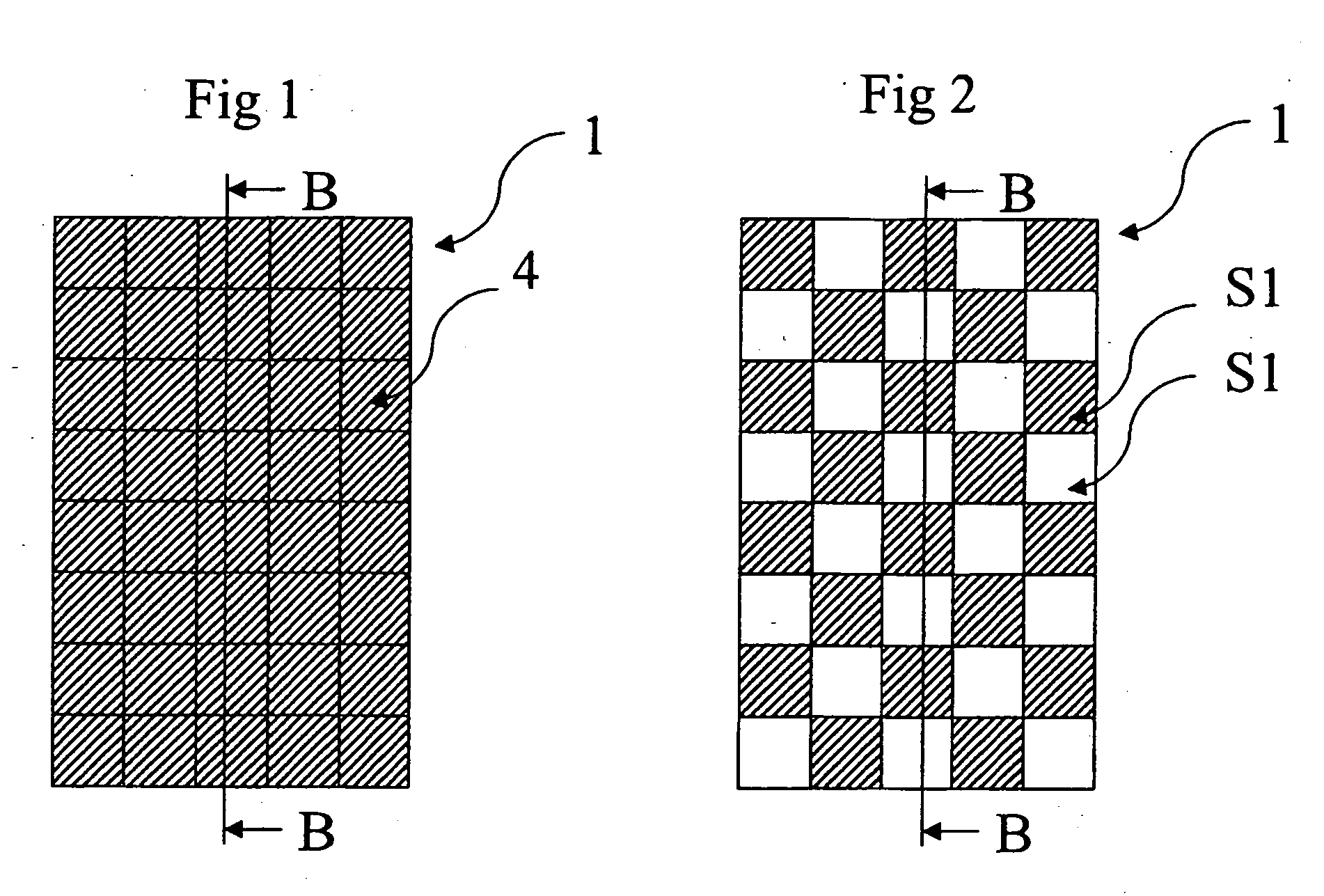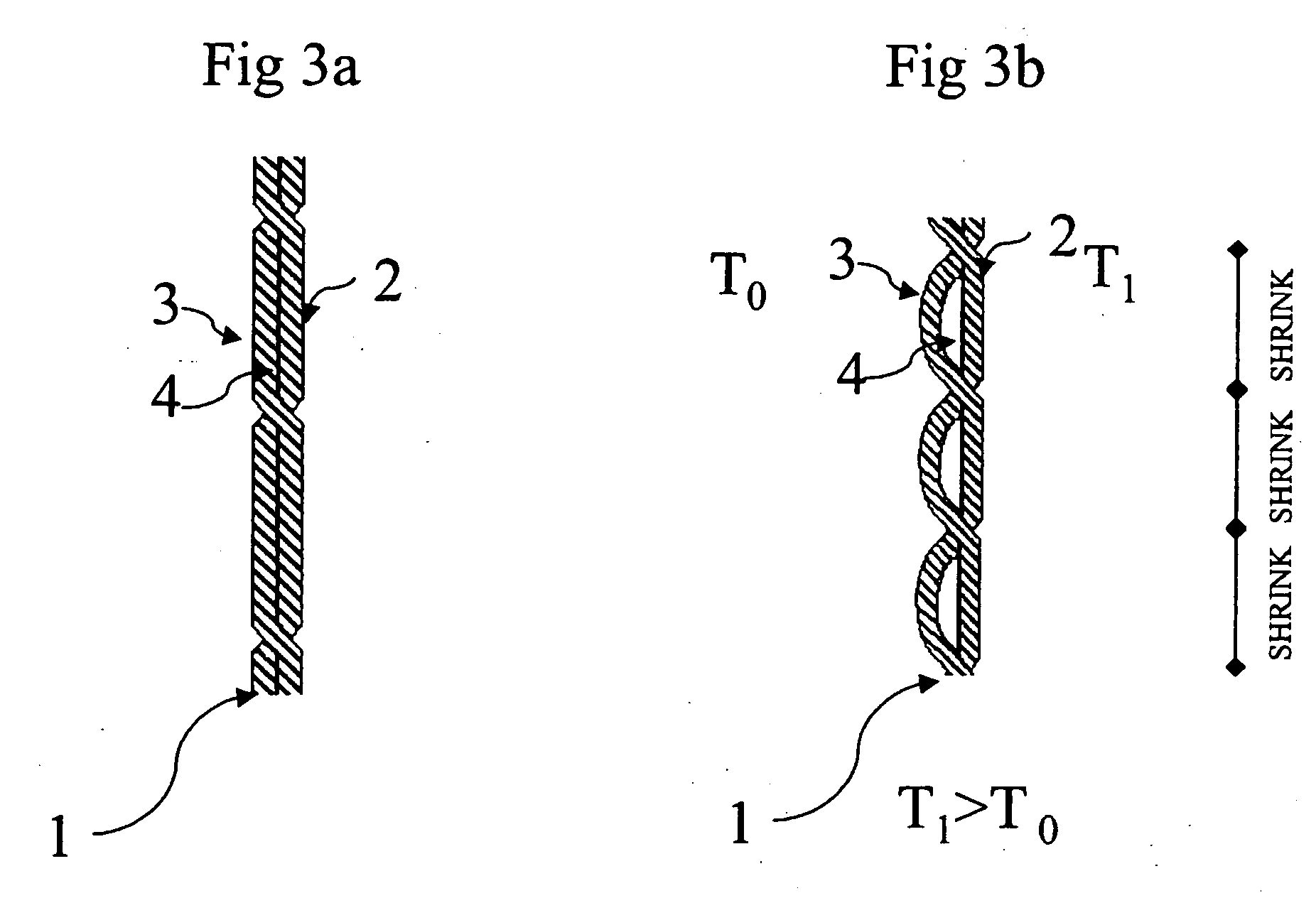Fabric for protective garments
a fabric and fabric technology, applied in the field of heat, flame and electric arc resistant fabrics, can solve the problems of affecting the respiratory activities of wearers, reducing overall wear comfort, and affecting so as to improve the comfort of wearers and increase heat and vapor dissipation.
- Summary
- Abstract
- Description
- Claims
- Application Information
AI Technical Summary
Benefits of technology
Problems solved by technology
Method used
Image
Examples
example 1
[0055] A blend of fibers, commercially available from E.I. du Pont de Nemours and Company, Wilmington, Del., U.S.A., under the trade name Nomex® N307, having a cut length of 5 cm and consisting of: [0056] 93 wt % of pigmented poly-metaphenylene isophthalamide (meta-aramid), 1.4 dtex staple fibers; [0057] 5 wt % of poly-paraphenylene terephthalamide (para-aramid) fibers; and [0058] 2 wt % of carbon core polyamide sheath antistatic fibers was ring spun into two types of single staple yarns (Y1 and Y2) using a conventional cotton staple processing equipment.
[0059] Y1 had a linear density of Nm 60 / 1 or 167 dtex and a twist of 850 Turns Per Meter (TPM) in Z direction and it was subsequently treated with steam to stabilize its tendency to wrinkle. Y1 was used as weft yarn.
[0060] Y2 had a linear density of Nm 70 / 1 or 143 dtex and a twist of 920 TPM in Z direction. Y2 was subsequently treated with steam to stabilize his tendency to wrinkle. Two Y2 yarns were then plied and twisted togethe...
example 2
[0075] Two plies weave fabrics with squared pockets of different sizes were prepared according to Example 1.
[0076] For the first ply, Y1 was used as weft and TY2 as warp.
[0077] For the second ply, the weft and warp were prepared as follows:
[0078] A blend of fibers, commercially available from E. I du Pont de Nemours and Company, Wilmington, Del., U.S.A., under the trade name Nomex® N305 having a cut length of 5 cm and consisting of: [0079] 75% pigmented pigmented poly-metaphenylene isophthalamide (meta-aramid)1.7 dtex staple fibers; [0080] 23% poly-paraphenylene terephthalamide (para-aramid) fibers; and [0081] 2% of carbon core poyamide sheath antistatic fibers was ring spun into two types of single staple yarns (Y3 and Y4) using a conventional cotton staple processing equipment.
[0082] Y3 had a linear density of Nm 60 / 1 or 167 dtex and a twist of 930 TPM in Z direction, and it was subsequently treated with steam to stabilize its tendency to wrinkle. Y3 was used as weft yarn.
[00...
example 3
[0091] Two plies weave fabrics with squared pockets of different sizes were prepared using the same materials as in Example 2. The two plies were woven together by alternating them so as to obtain a chess design, as shown in FIG. 2, where the same side of two adjacent pockets is alternately made of the two different separate single plies. The fabric was woven according to the construction depicted in FIG. 6.
[0092] Three weave fabrics having closed square pockets of 8×8, 16×16 and 32×32 mm, respectively were prepared. The three fabrics had 42 ends / cm (warp) (21 ends / cm for each ply), 48 weft / cm (weft) (24 ends / cm for each ply) and a specific weight of 200 g / m2. The same physical tests as in Example 1 were carried out on the three fabrics with exception of the electric arc testing according to ASTM F1959.
[0093] The fabrics were tested both as single layer (Fabric in Table 3) and as the outershell of the multilayer structure as in Example 1 (Garment in Table 3).
[0094] The results ar...
PUM
| Property | Measurement | Unit |
|---|---|---|
| time | aaaaa | aaaaa |
| temperature T1 | aaaaa | aaaaa |
| size | aaaaa | aaaaa |
Abstract
Description
Claims
Application Information
 Login to View More
Login to View More - R&D
- Intellectual Property
- Life Sciences
- Materials
- Tech Scout
- Unparalleled Data Quality
- Higher Quality Content
- 60% Fewer Hallucinations
Browse by: Latest US Patents, China's latest patents, Technical Efficacy Thesaurus, Application Domain, Technology Topic, Popular Technical Reports.
© 2025 PatSnap. All rights reserved.Legal|Privacy policy|Modern Slavery Act Transparency Statement|Sitemap|About US| Contact US: help@patsnap.com



